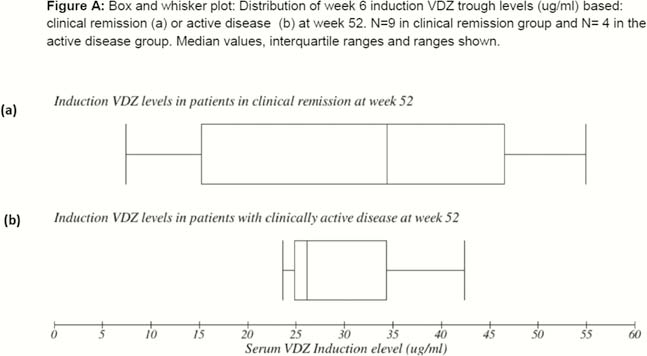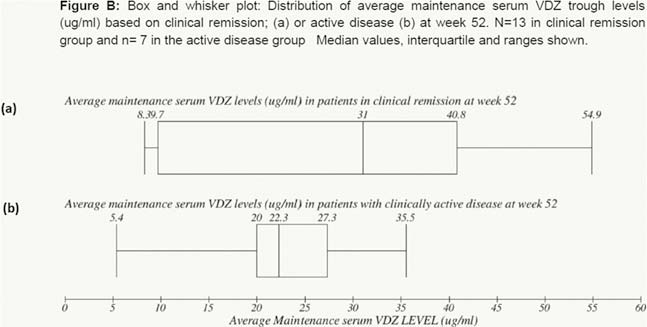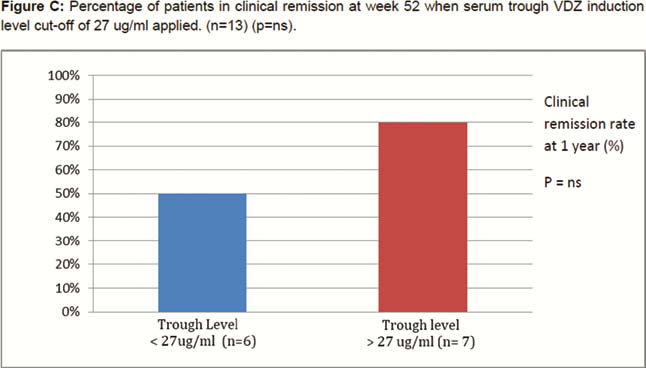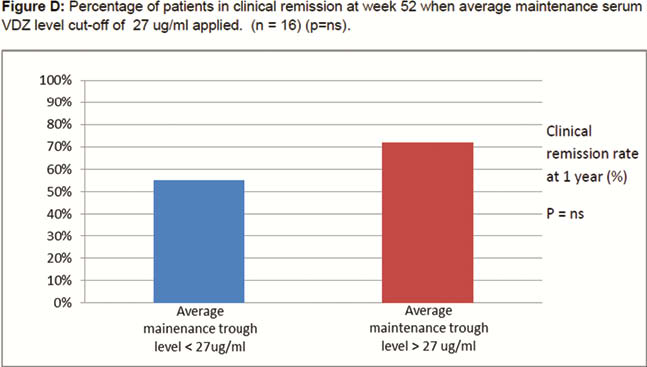P467 Can induction and maintenance serum vedolizumab levels predict long-term clinical outcome in inflammatory bowel disease (IBD)?
C. Miller1, H. Morgan2, A. Steel3, M. Wahed4
1Chelsea and Westminister Hospital Department of Gastroenterology, 1Gastroenterology, University College Hospital, London, UK, 2Gastroenterology, Chelsea and Westminister Hospital, London, UK, 3Gastroenterology, The Royal Liverpool University and Broadgreen University Hospitals NHS Trust, Liverpool, UK, 4Gastroenterology, Cheslsea and Westminister Hospital, London, UK
Background
Vedolizumab (VDZ) is an established IBD therapy, however, the role of therapeutic drug levels (TDM) is not fully established.1 Our aim was to assess whether week 6 and maintenance serum trough VDZ levels predict the clinical outcome at week 52.
Methods
A retrospective review of patients with Crohn’s disease (CD) or ulcerative colitis (UC) on VDZ was performed. Twenty-one IBD patients with serum VDZ trough level monitoring between January 2016 and December 2017 were identified. All patients received VDZ induction and maintenance as per standard protocol. Patients were excluded if complete dataset of VDZ levels was not available. Clinical remission was defined as a partial Mayo score < 2 for patients with UC or a Harvey–Bradshaw index (HBI) score < 4 for those with CD. A trough VDZ level ≥ 27 μg/ml cut-off was used to evaluate remission outcomes for both induction and average maintenance VDZ levels. Statistically, analysis was carried out using the Fisher exact test. Key demographics are 57% CD, 43% UC; Baseline HBI score: 11; Baseline Partial Mayo score: 9; Concurrent Immunomodulator: 55%
Results
1) Week 6 induction levels: At week 52, 69% of patients were in clinical remission. Those patients in remission had a higher mean and median trough VDZ levels (Figure A). When the induction serum trough VDZ level ≥ 27 μg/ml 30% more patients were in clinical remission at week 52, although this failed to reach statistical significance (




Conclusion
High levels of clinical remission in both CD and UC were seen. In our study, we could use a similar cut-off for induction trough VDZ levels to those used in the literature that correlated with positive outcomes.1 Although the observed levels used to predict remission did not reach statistical significance, this may represent a type 2 error in view of the small numbers of patient. Furthermore, it was not possible to assess whether there is a difference between CD and UC. For maintenance levels, our cut-off of 27 μg/ml was higher than that used in the literature that correlated with positive outcomes.1 Our data suggest there is some correlation between trough VDZ levels for both induction and average maintenance levels and long-term clinical remission. Our induction cut-off was similar to currently available data associated with positive outcomes.1 Further studies are required to fully establish the role of TDM.
Pouillon L, Vermiere S, Bossuyt P. Vedolizumab. Trough Level monitoring I inflammatory bowel disease: a state-of-the-art review. BMC Medicine volume 17, Article number: 89 (2019)


